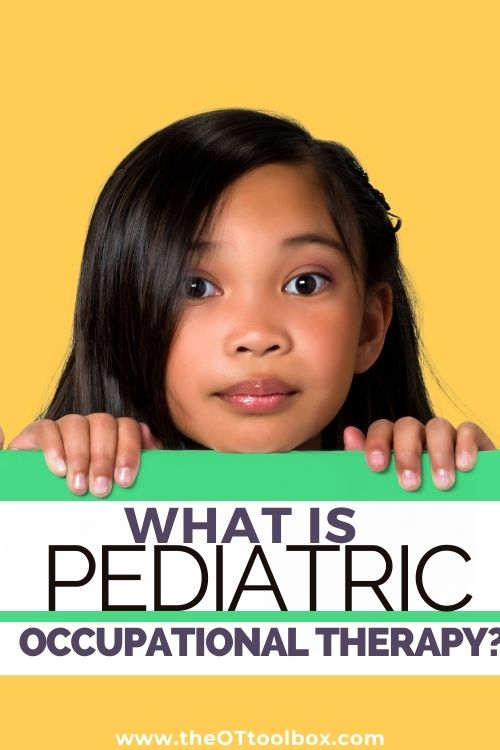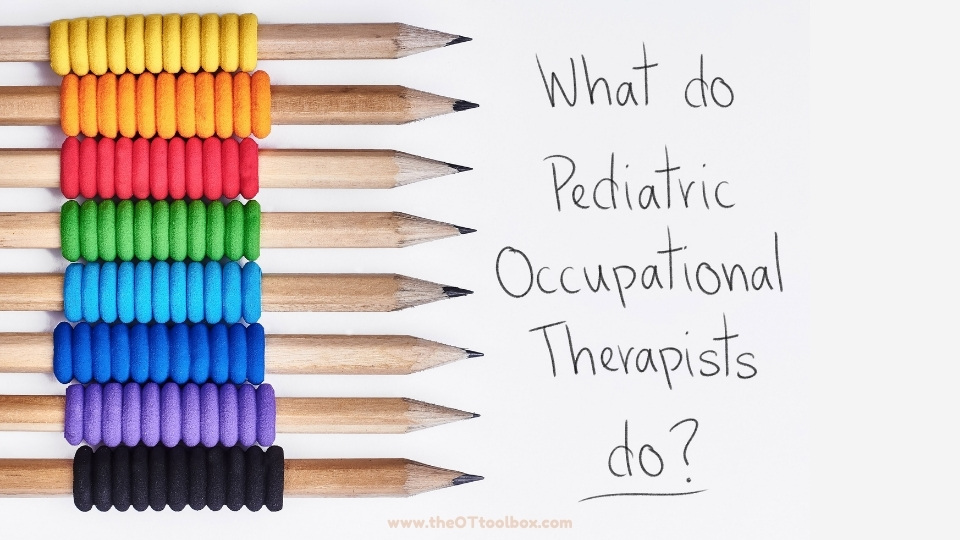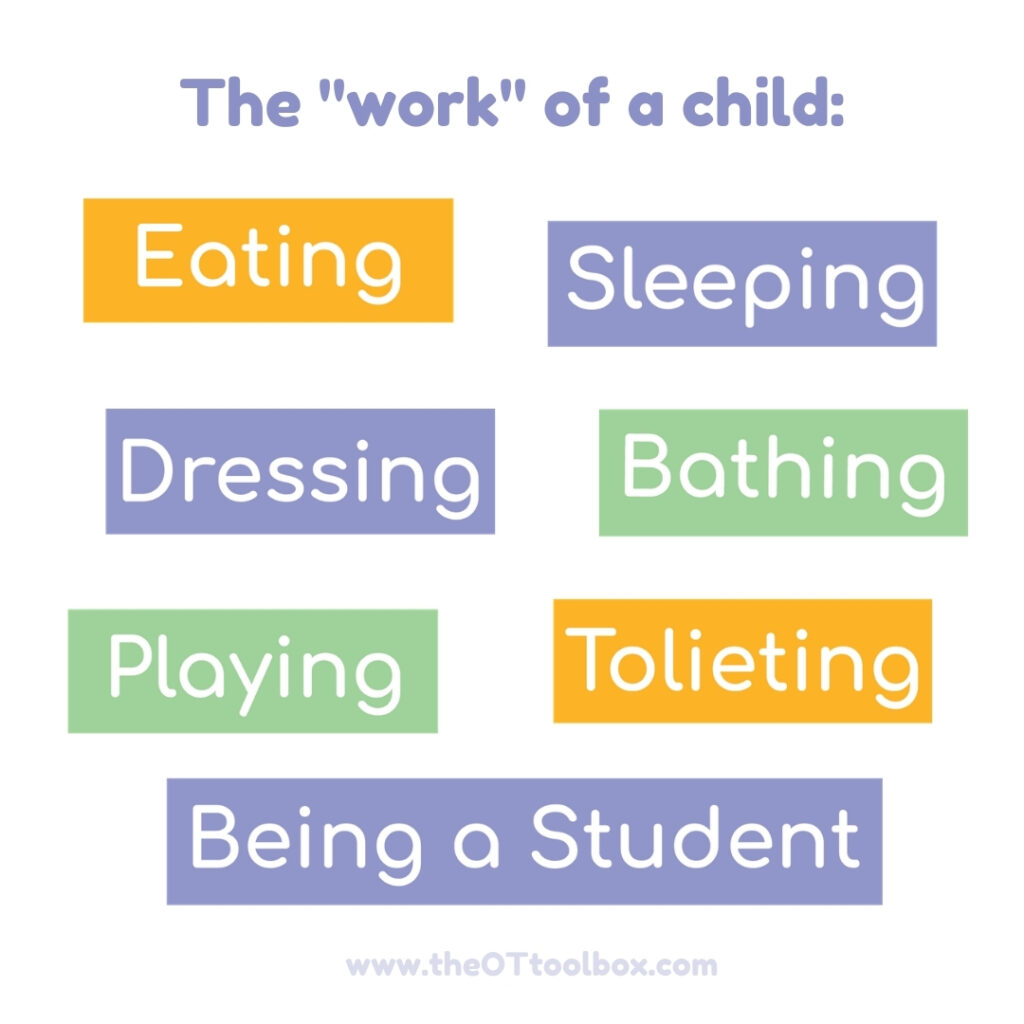Pediatric occupational therapy (OT) is a branch of occupational therapy that focuses on helping children with various physical, cognitive, and developmental disabilities or delays to perform daily activities and tasks. Pediatric OTs and OTAs support children of all ages, from infants to adolescents, but also the families, caregivers, and, in the school-based occupational therapy environment, educators, paraprofessionals, and anyone that is on the child’s support team.
Pediatric Occupational Therapy
What is a pediatric occupational therapist is a question that comes up a lot. “Pediatric occupational therapist” may be a term you have come across before. But what does it mean, exactly? You may be one of many people thinking to themselves, my kid doesn’t need a job, so what do you do?
Related: Have a child in therapy? Read more about specific activities your child may do in occupational therapy sessions.

Occupational therapy can seem like a misnomer, because these therapists don’t necessarily help people maintain careers. Although – they can! Allow me to explain.
When you search the word ‘occupation’ on Merriam-Webster, the first definition they provide is “an activity in which one engages”. For ease of explaining, many occupational therapists choose to define occupations as activities, or as meaningful activities, that you regularly engage in.
Occupational therapists seek to improve one’s engagement with their
occupations, which does include the work that they do in their career.
Pediatric occupational therapists do just the same, but for kids! They ensure that your child can best perform the occupations in their life. Below is a list of occupations that most children engage in.
All these occupations require many skills and abilities to successfully complete. To the untrained eye, it can be difficult to break down these everyday activities into their separate skills.
Occupational therapy practitioners complete something called an activity analysis to analyze the components of a single task.
They take something that can often feel automatic, like writing our names or putting on a shirt, and break it down into the smaller steps and skills that are required to complete the actions. The examples given, writing
one’s name or putting on one’s shirt, require gross motor skill, fine motor skill, intact cognition, and more.
Pediatric occupational therapists will evaluate a child for their fine motor skills, for example, so that they can determine their abilities to feed themselves, write in their role as a student, or manipulate small objects for play.
Additionally, your pediatric occupational therapist may address social and mental wellness needs of your child, as social and mental health is just as important to the engagement in occupations as physical health.

Does MY CHILD NEED OCCUPATIONAL THERAPY?
Your child may be recommended occupational therapy if they are showing signs of developmental delay in physical, social, emotional or mental domains. They may also benefit from occupational therapy to improve their handwriting , attention, or self-regulation.
Although each case is unique, occupational therapy is usually recommended to help your child become more independent. If your pediatrician or another health care professional suggests looking into
occupational therapy for your child, they will likely tell you why.
WHERE CAN MY CHILD RECEIVE PEDIATRIC OCCUPATIONAL THERAPY?
Pediatric occupational therapists provide their services in a number of settings. Many of them work in schools, outpatient therapy clinics, or in hospitals. Others work in community and home settings.
Occupational therapists provide interventions for people of all ages, and typically pediatric occupational therapists will serve newborns to age 18.
For those who are over 18, they are able to receive school-based occupational therapy services while they are still in high school, which can be up until age 21 or 22, depending on what state you live in.
WHAT Does an occupational therapy SESSION LOOK LIKE?
When your child first meets their pediatric occupational therapist, they will be evaluated. Typically, the first appointment is a bit longer than the ones that follow, so that a thorough evaluation can be done.
During that time, the therapist will use standardized and non-standardized assessments to determine where your child is physically, socially, emotionally, and/or mentally. Assessments may be done by the child on paper, or through a parent survey, or through therapist direction and observation.
Occupational therapists always strive to be evidence-based and client-centered in their practice. This means that whatever assessments and treatments they use with your child are backed by research and experience (evidence-based) and are specifically geared toward your child’s interests and needs (client-centered). Depending on the child’s age, interests and abilities, pediatric therapy can often look and feel like playing.
Read about occupational therapy play here.
In order to keep a child motivated, familiar tools are often used in therapy. Things like blocks, Legos, trampolines, Play-Doh, puzzles, scooters, beads, and gym mats can be found in just about any pediatric therapy clinic. The therapy that your child receives depends on the following factors: their therapeutic needs, your goals for therapy, the treatment setting and available materials, and the reimbursement coverage.
WHAT do PEDIATRIC OCCUPATIONAL THERAPISTS DO?
Now that we have laid some groundwork for what occupations are, where pediatric occupational therapists work and why a child may receive treatment, we can discuss all that pediatric therapists do. They help kids gain skills in functional tasks.
The goal of pediatric OT is to help children achieve independence and improve their quality of life by addressing their unique needs and challenges.
Pediatric OTs use a variety of techniques and tools, such as sensory integration therapy, play-based therapy, fine motor skill development, and adaptive equipment to help children achieve their goals.
This includes:
- Play
- Self-care skills- getting dressed, grooming, bathing, caring for oneself and the tasks associated with self-care
- Feeding and eating
- Learning and being a student
- Leisure activities
- Sleep
- Toileting and potty training
And all skills or aspects that allow kids to perform these “jobs”:
- Motor development and motor planning
- Feeding and oral motor skills
- Cognitive development
- Visual processing skills
- Sensory processing
- Self-regulation
- Social and emotional skills
- Emotional-regulation
- Social participation
- Executive functioning skills- organization, attention, working memory, planning, prioritization, impulse control, and other skills
- Fine and gross motor skills
- Safety in the home and community
- Balance and coordination

Pediatric occupational therapy providers do all of this and more. They screen and evaluate clients, write treatment plans and achievable goals, educate families and teachers, consult with other therapists and social workers, supervise Certified Occupational Therapy Assistants (COTAs), and determine the best possible path for your child. And then, when that path doesn’t work, they modify and try again.
What do pediatric occupational therapists do? They do all that they can to help your child be as successful as possible.
Pediatric Occupational Therapy FAQ
A few key and important points about pediatric occupational therapy can help to better explain pediatric OT.
Who does pediatric occupational therapy providers work with? Some of the conditions that pediatric OTs may treat include autism spectrum disorders, cerebral palsy, developmental delays, Down syndrome, sensory processing disorders, and more. Pediatric OTs also work closely with those who support their clients, including: parents, caregivers, teachers, and other healthcare professionals to create individualized treatment plans that address the child’s specific needs and goals.
In addition to helping children with physical and developmental disabilities, pediatric OTs also assist with emotional and behavioral issues that may affect their ability to function and participate in daily activities.
Where do pediatric occupational therapy providers work?
Pediatric OTs may work in a variety of settings, such as schools, early intervention settings in homes, hospitals, clinics, outpatient clinics, and private practices.
In the school setting, pediatric OTs and OTAs may support clients in the classroom (also called a push in model of therapy service) or in a pull out setting, depending on the needs. School based OT providers support students with education so that they can reach their full capacity.
Common areas addressed includes:
- Handwriting
- Fine motor skills impacting pencil grasp, cutting with scissors, manipulating school materials
- Self-regulation needs
- Clothing fasteners and self-care related to toileting or changing clothing for gym class
- Eating and managing food containers in the school lunch room
- Organizational needs related to executive functioning issues
- Other areas
School based OT can include early intervention in the preschool setting, early school years (kindergarten through primary school), middle school OT, high school OT, and even transitions post-high school
In the outpatient setting, a medical model of therapy can be addressed in the pediatric occupational therapy setting. These areas may include:
- Physical dysabilities impacting functional tasks
- Sensory processing needs/sensory integration
- Feeding skills
- Fine motor skills impacting functional performance
- Gross motor development
- Balance, coordination, mobility, etc.
- Executive functioning skills
- Social emotional development
- Sleep
- Behaviors impacting functional participation
- Many other goal areas!
What does a pediatric occupational therapy professional do in therapy sessions? Pediatric OTs often focus on helping children develop daily functional areas, and depending on the setting (school based OT or outpatient), this can differ vastly with the educational model of OT vs. the medical model of occupational therapy. Common areas addressed in pediatric occupational therapy includes: self-care skills, such as dressing, eating, and toileting, which can have a significant impact on their daily lives.
Finally, pediatric OT is an important part of a child’s overall daily functioning and life and can help children with a wide range of needs achieve their full potential.
Regenerate response

Sydney Thorson, OTR/L, is a new occupational therapist working in school-based therapy. Her
background is in Human Development and Family Studies, and she is passionate about
providing individualized and meaningful treatment for each child and their family. Sydney is also
a children’s author and illustrator and is always working on new and exciting projects.






